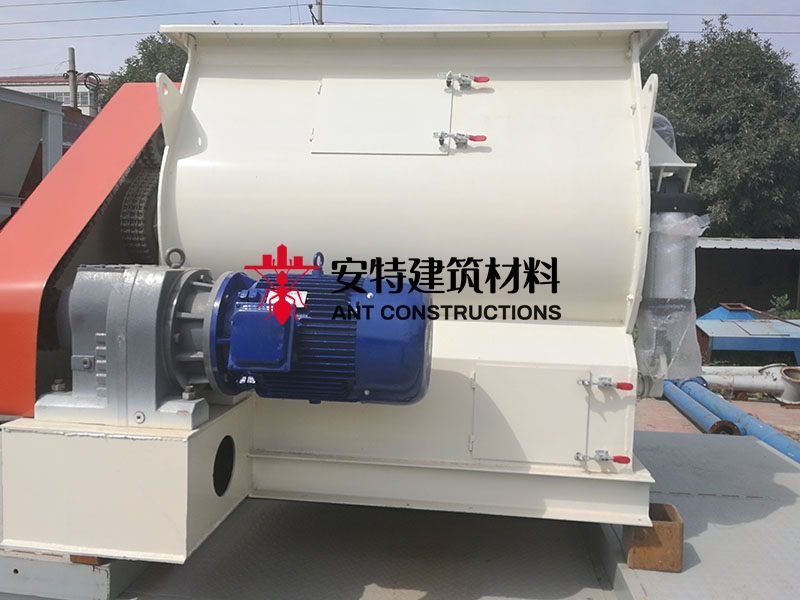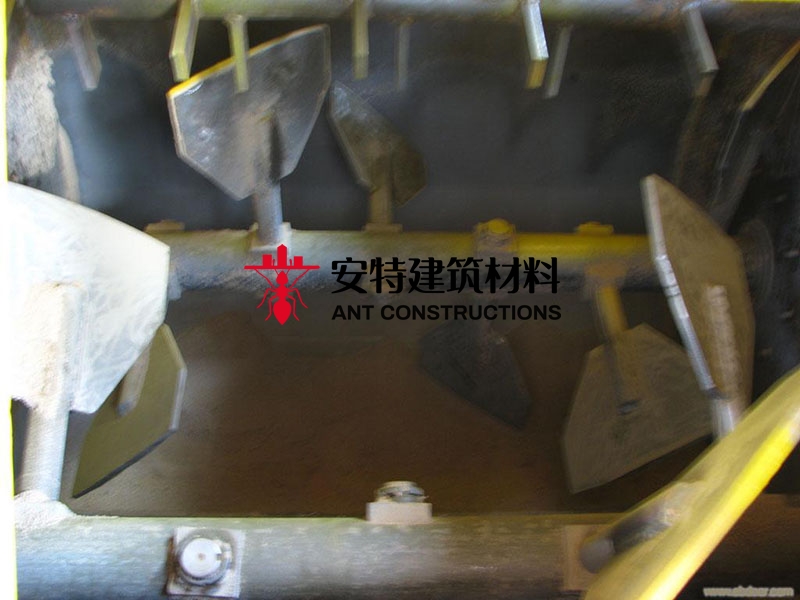How choose drymix equipment for wall putty dry mortar prodution
Author:ANT CONSTRUCTIONS Comefrom: Createdate:2020/9/23 15:16:29 Hits:125
How choose dry mixer equipment for wall putty dry mortar prodution
At present, the dry powder materials used in construction building materials mainly include dry powder mortar and putty powder. Inorganic insulation and thermal insulation mortar also belong to this category dry powder material. The main method of these materials in the production is to mix and stir. Such as cement, sand, fly ash, polymer powder, cellulose, polystyrene particles, etc. are uniformly mixed in a certain proportion. Therefore, it is very important to choose a suitable dry powder mixer in the production of putty powder and dry mortar

Vertical dry powder wall putty and mortar mixer
Five years ago, many putty powder manufacturers used vertical dry powder mixers base on the consideration of investment cost. The raw materials were manually feed to the material box and conveyed to the mixer by screw conveyor and various raw materials were mixed together. There are three obvious disadvantages of the vertical dry powder mixer:
The mixing uniformity is not good; the putty powder and dry powder mortar require high uniformity, because most of the active ingredients are small qty polymer powder, cellulose, etc., some of the components in the finished product have a ratio of 1% or even less than 0.1%. Therefore, the uniformity of the finished product is directly influence on the quality of the end product. The uniformity of the vertical mixer is acceptable when producing putty powder, but the gravity and density of cement, sand and other materials is quite different when producing special function dry mortar. It is quite difficult to have a good uniformity for producing special function dry mortar in vertical mixer.
The residual amount is too large; causing unevenness between each batch of materials. The working principle of the vertical mixer is that the vertical spiral rotates at a high speed, and the material is lifted from the bottom to the top, and then gradually mixed in a diffuse manner after passing through the bulk plate. The high-speed rotation of the spiral makes the components with high gravity such as quartz sand thrown far away from the axis because of the large centrifugal force and makes it cannot participate in the mixing. On the other hand, the side clearance of the spiral is large, generally 4-5 mm or even larger, and the vertical spiral side clearance is up to 10 mm, so each batch of materials will not be completely discharged, this cuased a large residue. Due to inaccurate operating procedures, the residues of each batch of materials are different, which directly affects the content of various components in the next batch of materials, this resulting in unevenness between each batch of materials. The more important thing the less ratio of the addtives materials are, the more expensive they are. The price is thousands of usd per ton, so you can imagine it is a great loss.
The maintenance rate is too high; the bearings of the vertical dry powder mixer are located at the top and bottom ends, and the bottom bearing will contact the material, which will easily cause the sudden death and damage of the bearing. The bearing needs to be replaced regularly, and the maintenance rate is very high.
With increasingly fierce competition today, once unqualified products reach the market, quality problems will occur during construction, such as indoor paint cracking, hollowing, poor scratching, etc., outdoor protective layer and tile hollowing off and even blown off by strong winds, rainwater seeps through the cracks into the outer wall surface, and the fire prevention is low and easy to aged. Therefore, the quality of products restricts the smooth flow of sales. Recommendations: In addition to check the formula and the quality of various raw materials,it is also important to choose the suitable mixer. So what kind of dry powder mixer should I choose?

Horizontal dry mortar wall putty mixer
Horizontal ribbon blade wall putty dry mortar mixer
Horizontal dry powder mixer has become the first choice at present. There are 1 ton, 2 ton and bigger capacity multi ribbon mixer according to the size of the mixing volume. The appearance of this series of mixers is cylindrical and the material is carried through the multi-layer spiral belt in the cylinder. Multi-layer spiral ribbon design, outer spiral ribbon narrow inner spiral width, the direction of two adjacent spiral ribbons is reverse design. During the flow of materials in the cylinder, multiple material flow path are formed, interpenetrating, displacing and mixing repeatedly. The wall of the tumbling mixing cylinder on both sides has no block and dead angle, which is an ideal choice for mixing dry wall putty powder materials.
Horizontal twin shafts paddle blade wall putty dry mortar mixer
However, the more efficient dual-shaft zero-gravity mixer is widely used in the complete production line with large output: the horizontal dual-shaft paddle mixer has faster mixing speed, good mixing quality, wide application range in large-scale external insulation Materials and dry powder coatings. The material in the mixing machine is subjected to the action of two oppositely rotating shafts and undergoes a compound movement. On the one hand, the blade dispatch material moving counterclockwise along the inside of mixer, and on the other hand, it turns the material left and right. At the intersection of the two shafts, it becomes a weightless zone. In this area, no mater what is the shape, size and density of the material, It can make the material float in a state of instantaneous weightlessness, which makes the material form an all-round continuous cyclic turning in the machine tank, interlacing and shearing each other, so as to achieve the effect of rapid, soft and uniform mixing.


The material particles in the machine have circular movements and axial movements under the blades; according to the state of material mixing status, there are convection mixing, shear mixing and diffusion mixing.
Convective mixing;
the materials betwin the two shaft will flow in the shaft direction respectively. After reaching the shaft end, due to the action of a set of small-angle blades at the shaft end, the material turns to another shaft area to move, so that the material in the entire machine forms a horizontal plane and circulating flow; on the other hand, the materials in the two shaft areas will rotate around their respective shaft at the same time, and each shaft area forms a vertical surface and circulating material flow; and the materials at the junction of the two shaft areas also flow transversely to the other shaft area. Because of this multi-directional compound circulation convection, the materials in the machine will move and mix from one place to another more quickly.
Shearing mixing:
The materials form shearing surfaces with each other under the action of the blades, and the masses or particles of the materials slide and collide with each other to form shearing and mixing.
Diffusion mixing;
The diffusion mixing exists in the entire machine, but it is more pronounced in the area near the center line of the machine, because the two shafts rotate in opposite directions and there is an overlapping area of the movement generated by the blades in the machine body, which makes the area near the center line material is affected by the rotating blade. The material turned by the blade in this area is scattered in the air due to inertia at the moment it leaves the blade. During the scattering process, the material friction and penetrate each other, forming a fluidized area near the centerline of the machine body. Each particle can move freely in the fluidized area, and the material particles are fully diffused and mixed in the free movement. The friction in this area is small, the mixing is light and gentle, and there is no segregation in the mixing. Especially when the particulate material is in the fluid state, the diffusion and mixing effect is better. The formation of the fluidized zone, coupled with the effects of convection mixing and shear mixing, makes the mixing speed of the biaxial blade mixer faster than the general mixer and the mixing uniformity is high.
All in all, as horizontal dry powder mixers have become the main choice, and vertical dry powder mixers have gradually withdrawn from the stage, it is a wise choice to choose different horizontal dry powder mixers according to their needs and output. For large output full set production line equipment, please contact Henan Ant Constructions engineers freely please.










